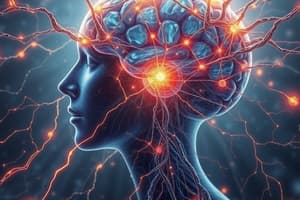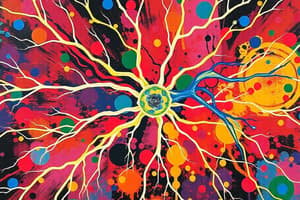Podcast
Questions and Answers
What role do calcium ions play in muscle contraction?
What role do calcium ions play in muscle contraction?
Calcium ions enter muscle cells, triggering the sliding of actin and myosin filaments towards each other, resulting in muscle contraction.
How do plants differ from animals in terms of coordination?
How do plants differ from animals in terms of coordination?
Plants do not have a nervous system and rely on chemical means for control and coordination through hormones.
Define tropic movements in plants.
Define tropic movements in plants.
Tropic movements are growth movements in plants that occur in a specific direction in response to a stimulus.
What is geotropic movement and how does it affect plant roots and stems?
What is geotropic movement and how does it affect plant roots and stems?
Describe the phenomenon of phototropic movement in plants.
Describe the phenomenon of phototropic movement in plants.
What is hydrotropic movement and how do roots exhibit this behavior?
What is hydrotropic movement and how do roots exhibit this behavior?
Explain thigmotropic movement in plants with an example.
Explain thigmotropic movement in plants with an example.
How do plant hormones influence tropic movements?
How do plant hormones influence tropic movements?
Flashcards
Control and Coordination
Control and Coordination
The processes that allow a living organism to respond to its environment and maintain internal balance.
Nervous System
Nervous System
The network of specialized tissues responsible for control and coordination in complex animals, consisting of neurons.
Neuron
Neuron
The basic functional unit of the nervous system, responsible for transmitting nerve impulses.
Cyton
Cyton
Signup and view all the flashcards
Dendrites
Dendrites
Signup and view all the flashcards
Axon
Axon
Signup and view all the flashcards
Axon Terminals
Axon Terminals
Signup and view all the flashcards
Myelin Sheath
Myelin Sheath
Signup and view all the flashcards
Spinal Cord's Role
Spinal Cord's Role
Signup and view all the flashcards
Peripheral Nervous System (PNS)
Peripheral Nervous System (PNS)
Signup and view all the flashcards
Cranial Nerves
Cranial Nerves
Signup and view all the flashcards
Spinal Nerves
Spinal Nerves
Signup and view all the flashcards
Autonomous Nervous System
Autonomous Nervous System
Signup and view all the flashcards
Sympathetic Nervous System
Sympathetic Nervous System
Signup and view all the flashcards
Parasympathetic Nervous System
Parasympathetic Nervous System
Signup and view all the flashcards
Cerebrum
Cerebrum
Signup and view all the flashcards
Adrenaline
Adrenaline
Signup and view all the flashcards
Fight-or-Flight Response
Fight-or-Flight Response
Signup and view all the flashcards
Function of Adrenaline
Function of Adrenaline
Signup and view all the flashcards
Effects of Adrenaline
Effects of Adrenaline
Signup and view all the flashcards
Progesterone
Progesterone
Signup and view all the flashcards
Hypothalamus
Hypothalamus
Signup and view all the flashcards
Medulla
Medulla
Signup and view all the flashcards
Reflex Action
Reflex Action
Signup and view all the flashcards
Reflex Arc
Reflex Arc
Signup and view all the flashcards
Receptor
Receptor
Signup and view all the flashcards
Effector
Effector
Signup and view all the flashcards
Plant Hormones
Plant Hormones
Signup and view all the flashcards
Tropic Movements
Tropic Movements
Signup and view all the flashcards
Geotropic Movement
Geotropic Movement
Signup and view all the flashcards
Phototropic Movement
Phototropic Movement
Signup and view all the flashcards
Hydrotropic Movement
Hydrotropic Movement
Signup and view all the flashcards
Thigmotropic Movement
Thigmotropic Movement
Signup and view all the flashcards
How do plants coordinate?
How do plants coordinate?
Signup and view all the flashcards
Pituitary Gland
Pituitary Gland
Signup and view all the flashcards
Growth Hormone (GH)
Growth Hormone (GH)
Signup and view all the flashcards
Thyroid Gland
Thyroid Gland
Signup and view all the flashcards
Thyroxine (T4)
Thyroxine (T4)
Signup and view all the flashcards
Adrenal Glands
Adrenal Glands
Signup and view all the flashcards
Insulin
Insulin
Signup and view all the flashcards
Testosterone
Testosterone
Signup and view all the flashcards
Oestrogen
Oestrogen
Signup and view all the flashcards
Study Notes
Control and Coordination
- Living organisms constantly interact with their environment and must respond to stimuli for survival
- Control and coordination are vital for survival, especially in complex animals
- The nervous system is the primary control and coordination system in complex animals
Nervous System
- The nervous system is comprised of specialized nervous tissue, mainly neurons
- Neurons are the functional units of the nervous system, responsible for transmitting nerve impulses
- A neuron consists of a cell body (cyton), dendrites (hair-like structures receiving impulses), an axon (a tail-like structure), and a myelin sheath (insulating layer around the axon)
Types of Neurons
- Sensory neurons: Receive signals from sensory organs
- Motor neurons: Send signals to muscles or glands
- Association neurons (Interneurons): Relay signals between sensory and motor neurons
Nervous System in Humans
- The human nervous system is divided into the central nervous system (CNS) and the peripheral nervous system (PNS)
- The CNS consists of the brain and spinal cord, controlling body functions
- The PNS connects the CNS to other body parts, divided into somatic (voluntary) and autonomic (involuntary) systems
Central Nervous System (CNS)
- The brain is the control center of the human body
- The spinal cord acts as a relay system between the brain and the peripheral nervous system
Human Brain
- The brain is a complex organ made of nervous tissue, with a folded structure maximizing surface area
- It is protected by the skull and meninges, and cushioned by cerebrospinal fluid
- The brain is divided into three main parts: forebrain, midbrain, and hindbrain
Parts of the Human Brain
- Forebrain: Includes cerebrum (largest part, controlling voluntary actions, sensory perceptions, learning, and memory) and hypothalamus (regulating body temperature, sleep-wake cycles, and thirst)
- Midbrain: A small region, important for eye movements and auditory functions
- Hindbrain: Includes cerebellum (coordinating motor functions) and medulla oblongata (controlling involuntary actions like heartbeat and breathing)
Reflex Action
- Reflex action is an involuntary response to a stimulus, involving a reflex arc
- A reflex arc involves sensory neurons, relay neurons in the spinal cord, and motor neurons, acting very quickly without conscious thought
- The reflex happens at the spinal cord level (CNS), not needing brain intervention
Muscular Movements and Nervous Control
- Muscles contract in response to nerve signals
- Muscle tissue contains actin and myosin filaments causing contraction when stimulated
Coordination in Plants
- Plants lack a nervous system, but use plant hormones for coordination
- Plant hormones are chemical signals regulating growth and development
Tropic Movements
- Growth in response to a directional stimulus (e.g., gravity, light)
- Geotropism: Growth in response to gravity (roots positive, stems negative)
- Phototropism: Growth in response to light (stems positive, roots negative)
- Hydrotropism: Growth in response to water
- Thigmotropism: Growth in response to touch
Nastic Movements
- Non-directional movements in response to stimuli (e.g., touch)
- Independent of the direction of stimulus
Plant Hormones
- Auxins: Promote cell growth and differentiation
- Gibberellins: Promote cell division, seed germination, and fruit development
- Cytokinins: Promote cell division and lateral growth
- Abscisic acid: Inhibits growth, promotes dormancy
- Ethylene: Promotes fruit ripening
Endocrine System
- Endocrine glands secrete hormones directly into the bloodstream
- Hormones regulate various body functions and coordinate with the nervous system
- The hypothalamus, pituitary gland, thyroid, adrenal glands, and pancreas are major endocrine glands
Studying That Suits You
Use AI to generate personalized quizzes and flashcards to suit your learning preferences.
Related Documents
Description
Explore the crucial processes of control and coordination in living organisms, focusing on the role of the nervous system. This quiz covers the structure and function of neurons, their types, and how they facilitate responses to stimuli. Test your knowledge on the essential aspects of the nervous system in complex animals, including humans.





